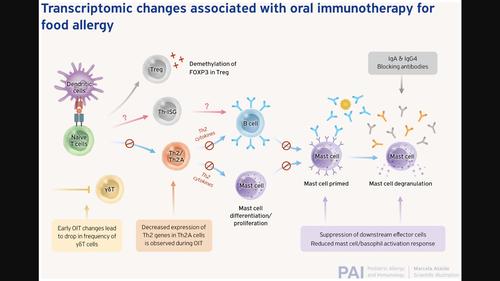当前位置:
X-MOL 学术
›
Pediatric Allergy Immunol.
›
论文详情
Our official English website, www.x-mol.net, welcomes your feedback! (Note: you will need to create a separate account there.)
Transcriptomic changes associated with oral immunotherapy for food allergy
Pediatric Allergy and Immunology ( IF 4.4 ) Pub Date : 2024-03-23 , DOI: 10.1111/pai.14106 Sarah E. Ashley 1, 2, 3 , Anthony Bosco 4, 5 , Mimi L. K. Tang 1, 2, 3
Pediatric Allergy and Immunology ( IF 4.4 ) Pub Date : 2024-03-23 , DOI: 10.1111/pai.14106 Sarah E. Ashley 1, 2, 3 , Anthony Bosco 4, 5 , Mimi L. K. Tang 1, 2, 3
Affiliation

|
This review summarizes recent advances in characterizing the transcriptional pathways associated with outcomes following Oral Immunotherapy. Recent technological advances including single‐cell sequencing are transforming the ways in which the transcriptional landscape is understood. The application of these technologies is still in its infancy in food allergy but here we summarize current understanding of gene expression changes following oral immunotherapy for food allergy and specific signatures underpinning the different clinical outcomes of desensitization and remission (sustained unresponsiveness). T helper 2A cells have been identified as a cell type which correlates with disease activity and is modified by treatment. Molecular features at study entry may differentiate individuals who achieve more positive outcomes during OIT. Recent findings point to T cell anergy and Type 1 interferon pathways as potential mechanisms supporting redirection of the allergen‐specific immune response away from allergy towards remission. Despite these developments in our understanding of immune mechanisms following OIT, there are still significant gaps. Additional studies examining immune signatures associated with long term and well‐defined clinical outcomes are required to gain a more complete understanding of the pathways leading to remission of allergy, in order to optimize treatments and gain improved outcomes for patients.
中文翻译:

与食物过敏口服免疫疗法相关的转录组变化
本综述总结了与口服免疫治疗结果相关的转录途径特征的最新进展。包括单细胞测序在内的最新技术进步正在改变人们理解转录景观的方式。这些技术在食物过敏中的应用仍处于起步阶段,但在这里我们总结了目前对口服免疫治疗食物过敏后基因表达变化的理解,以及支持脱敏和缓解(持续无反应)不同临床结果的具体特征。辅助 T 2A 细胞已被确定为与疾病活动相关并通过治疗进行修饰的细胞类型。研究开始时的分子特征可能会区分在 OIT 期间取得更积极结果的个体。最近的研究结果指出,T 细胞无反应性和 1 型干扰素途径是支持将过敏原特异性免疫反应从过敏转向缓解的潜在机制。尽管我们对 OIT 后免疫机制的理解取得了这些进展,但仍然存在重大差距。需要进行更多研究来检查与长期和明确的临床结果相关的免疫特征,以更全面地了解导致过敏缓解的途径,从而优化治疗并改善患者的结果。
更新日期:2024-03-23
中文翻译:

与食物过敏口服免疫疗法相关的转录组变化
本综述总结了与口服免疫治疗结果相关的转录途径特征的最新进展。包括单细胞测序在内的最新技术进步正在改变人们理解转录景观的方式。这些技术在食物过敏中的应用仍处于起步阶段,但在这里我们总结了目前对口服免疫治疗食物过敏后基因表达变化的理解,以及支持脱敏和缓解(持续无反应)不同临床结果的具体特征。辅助 T 2A 细胞已被确定为与疾病活动相关并通过治疗进行修饰的细胞类型。研究开始时的分子特征可能会区分在 OIT 期间取得更积极结果的个体。最近的研究结果指出,T 细胞无反应性和 1 型干扰素途径是支持将过敏原特异性免疫反应从过敏转向缓解的潜在机制。尽管我们对 OIT 后免疫机制的理解取得了这些进展,但仍然存在重大差距。需要进行更多研究来检查与长期和明确的临床结果相关的免疫特征,以更全面地了解导致过敏缓解的途径,从而优化治疗并改善患者的结果。



























 京公网安备 11010802027423号
京公网安备 11010802027423号